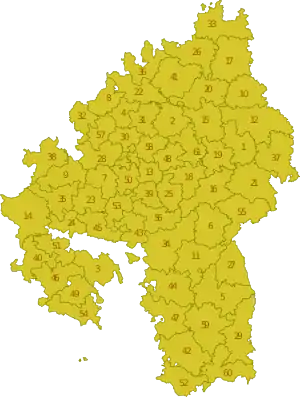Oberamt (Württemberg)
Oberamt (German: [ˈoːbɐʔamt], plural Oberämter) was the designation of an administrative unit in the German state of Württemberg, introduced in 1758 instead of Amt. Literally translated, the term means Upper, Senior, Higher or Superior Office. It was in use until 1934, after the nazi seizure of power, when the Oberämter were renamed Kreise with the Kreisordnung of Württemberg and their number was considerably reduced by mergers in 1938.

History
Duchy
The subdivision of the Duchy of Württemberg (until 1495 county) into public administration called Ämter reflected in its diversity the gradual growth of the territory. In addition to the secular offices, which made up the largest part of the state, there were monastic, rentier and chamber offices. Usually, a secular office consisted of the eponymous town and the surrounding villages as Amtsorte or Amtsflecken, but the districts differed considerably in area and population, and complicated borderlines with many exclaves marked the map. Some larger offices, such as the Amt Urach, were divided into several Unterämter (“sub-offices”). For clarification, the offices themselves were called Oberamt from 1758 on, without structural reforms being connected with this renaming. The ducal civil servant, who was traditionally called Vogt (about equal to “bailiff”) and who managed the administrative affairs at the official level, held the title Oberamtmann from 1759. From that day on, “all and every secondary title with the bailiff′s word was to cease immediately and only the Oberamtmann′s name was to be valid.”[1] He was responsible for the implementation of government measures in his bailiwick, for example by publishing new laws, receiving complaints from subjects and forwarding them to the appropriate higher authorities. He also warned persons who only slightly violated laws. In the Amtsversammlung, representatives of the official town and places of office discussed common matters. For example, it was decided here how the road construction in the district was to be financed. The official assembly also elected its representatives for the so-called "Landschaft".
Kingdom
After the areas that had been assigned to the House of Württemberg as a result of the upheavals of the Napoleonic era since 1803 were initially administered separately as "Neuwürttemberg", the organisational edict[2] of 1806 - Württemberg had in the meantime risen to become the Kingdom of Württemberg - initiated the creation of uniform structures. In the following years the declaration of intent "An expedient division and merger of the senior and staff offices will be made gradually. and the whole country, regardless of historical and denominational circumstances, will be newly divided into approximately equal senior offices, the number of which was reduced to 64 by 1810 and to 63 by 1819 with the abolition of the Albeck senior office.[3] A special role was played by the Residence City Stuttgart, where the Stadtdirektion fulfilled the corresponding tasks.
The higher offices were subordinate to the Ministry of the Interior and were responsible for all essential areas of state administration, only the financial system was in the hands of the Kameralämter since 1806. Since 1814[4] every senior office received a public health officer under the title Oberamtsarzt (senior physician).[5] According to the understanding of the state at that time, administration and jurisdiction were not separate, rather the senior civil servant presided over the High Court in personal union. Municipal self-governance and the right to a say of the estates, which had already been temporarily restricted under Duke Carl Eugen, was suspended by King Friedrich.
King Wilhelm I. took over the government in 1816 and immediately began comprehensive reforms, which led to the constitution[6] of 1819 and thus changed Württemberg from an absolute to a constitutional Monarchy. The edicts issued on 31 December 1818 regulated various aspects of the restored local self-government:
- The sheriff's offices became Selbstverwaltungskörper.
- The municipalities of an Oberamt together formed the Amtskörperschaft, a territorial authority with its own parliament (Amtsversammlung) and its own assets (Amtspflege).
- This resulted in a double function of the senior civil servant, who was not only a civil servant as before, but also functioned as organ of the official authority.
- Administration and justice were separated from each other at the Oberamt level.
Chapter V of the Constitution contained detailed information on the administrative structure and rights of municipalities and official bodies. In particular, § 64 provided that Oberämter limits could only be changed by law, i.e. with the consent of parliament. This possibility was only used very sparingly; only in 1842 were major changes made, affecting around thirty municipalities.[7] A bill introduced by the government in 1911 to simplify administration in the sense of cost savings provided for only 42 Oberämter, but was rejected by the Chamber of Deputies.
People's state
In 1919, renewed consideration was given to reducing the number of Oberämter and restoring the uniformity lost due to the different population trends. After the Landtag had agreed to the abolition of the Cannstatt Oberamt on 1 October 1923,[8] the government attempted to dissolve the Oberämter of Blaubeuren, Brackenheim, Neresheim, Spaichingen, Sulz, Weinsberg and Welzheim on 1 April 1924 by emergency decree, covered by an enabling act. The protests caused by this led to the resignation of the government, the emergency decree was withdrawn and subsequently only the Weinsberg Oberamt was abolished (on 1 April 1926).[9]
Nazi dictatorship
In 1933, the organs of local self-government were dissolved.[10] After the Oberamtmann had already been titled Landrat since 1928, following the Prussian style, the Kreisordnung of 1934[11] replaced the names Oberamt by Kreis and Amtskörperschaft by Kreisverband, but did not yet include a change of boundaries. Only with the administrative district reform of 1938 were 27 of the remaining 61 districts abolished.[12]
Descriptions of the local authorities
From 1824 to 1886, all the Oberämter were statistically processed and their history, communities, population figures and the characteristics of their inhabitants were elaborately described in print.
The mainly catholic “new Württemberg” areas, e.g. in Oberschwaben, as described from the point of view of the Württemberg bureaucracy in evangelically influenced Stuttgart, often bear certain characteristics. Quote from the description of Oberamt Ravensburg, p. 29: “The character of the inhabitants is generally praised more than in other neighbouring districts, it is described as simple and trusting”.
The Oberamt descriptions have become sought-after and expensively paid collector's items; therefore all volumes were reprinted in the 1970s. Most of these reprints meanwhile are out of print again. All of them are now available in digital form, see Wikisource.
Today's traces of the Oberamt boundaries
In the former Württemberg region of contemporary Baden-Württemberg, often the Amtsgericht courts are located in the former Oberamt cities.
The ecclesiastical administrative structures of the Evangelical-Lutheran Church in Württemberg also largely reflect the former higher offices. In most of the former cities of the Oberamt cities there is still the seat of a deanery, whose area of responsibility is the same as the former Oberamt. Deviations from this mainly occur in the predominantly Catholic areas and wherever new deaneries were established due to an increase in church members, such as in Ditzingen or Bernhausen.
List of the Württemberg Oberämter (1811 to 1934)

References
- Herzog Karl von Württemberg (1843). Generalreskript den Titel und Rang der Oberamtmänner betreffend vom 1. Febr. 1759 [General Rescript concerning the Title and Rank of the Oberamtmänner from Febr. 1. 1759]. Sammlung der württembergischen Regierungsgesetze. Band III [Collection of the Württemberg government laws, Vol.III] (in German). Tübingen: Zeller. p. 778.
- "Organisationsedikt vom 18. März 1806". Archived from the original on 2016-03-05. Retrieved 2020-05-02.
- Königliches Manifest, die neue Eintheilung des Königreichs betreffend, vom 27. Oktober 1810 Archived 2016-03-04 at the Wayback Machine (PDF; 2,9 MB)
- Königlich Württembergisches Staats- und Regierungsblatt (ed.). Generalverordnung, die Organisation der Medizinalverfassung im Königreiche betreffend vom 14./22. März 1814 [General Ordinance concerning the Organization of the Medical Constitution in the Kingdom of March 14/22, 1814] (in German). Stuttgart. pp. 121–136.
- Zoeppritz (1925). Das Oberamtsgesetz von 1912. Medizinisches Correspondenzblatt für Württemberg (in German). 25. Stuttgart. p. 377.
- "Verfassungsurkunde vom 25. September 1819". Archived from the original on 2017-12-15. Retrieved 2020-05-02.
- Law, concerning changes in the boundaries of the upper administrative districts of July 6, 1842, effective September 1, 1842 (RegBl 1842/385)
- Law, concerning the division of the Cannstatt Oberamt District (RegBl 1923/385)
- Gesetz, betreffend Aufteilung des Oberamtsbezirks Weinsberg (RegBl 1926/89)
- "Gesetz über die vorläufige Vertretung der Amtskörperschaften vom 25. April 1933". Archived from the original on 2016-03-05. Retrieved 2020-05-02.
- "(Württembergische) Kreisordnung (1934)". www.verfassungen.de. Retrieved 19 January 2021.
- "Law on the division of the country of 25 April 1938". Archived from the original on 4 March 2016. Retrieved 2 May 2020.
- merged with Oberamt Ulm in 1819.
- renamed Oberamt Welzheim in 1819.
- previously Amt Grüningen (before 1718 and 1722–1758), which was continued as Oberamt Markgröningen after 1758, with a diminished Amt area and was split between Oberämter Ludwigsburg and Vaihingen an der Enz in 1806.
- renamed Oberamt Laupheimin 1842.
Literature
- Walter Grube: Vogteien, Ämter, Landkreise in Baden-Württemberg. Stuttgart 1975, ISBN 3-17-002445-0
- Historischer Atlas von Baden-Württemberg, Karten VII,4 und VII,5 mit Beiwort. Stuttgart 1976
Weblinks
| Wikimedia Commons has media related to Karten der Amtsbezirke um 1600. |
| Wikimedia Commons has media related to Karten der Oberamtsbezirke um 1800. |
| Wikisource has original text related to this article: |